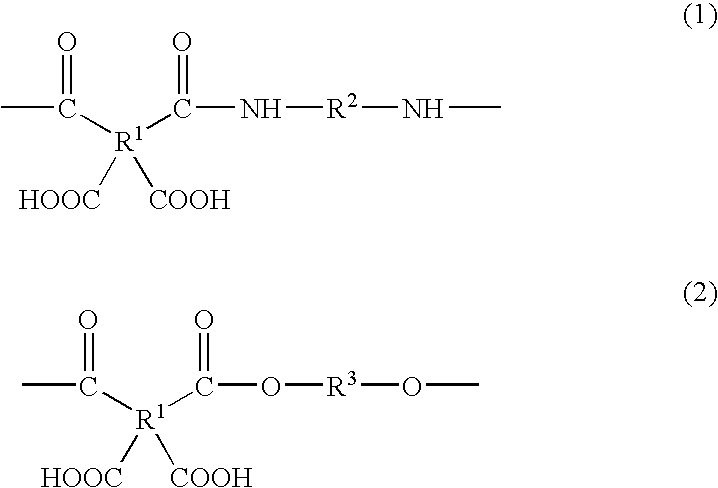Inkjet ink and method for forming cured film using the same
a technology of inkjet ink and cured film, which is applied in the field of inkjet ink, can solve the problems of requiring considerable financial investment in equipment, difficult to form very fine patterns, and reducing resolution
- Summary
- Abstract
- Description
- Claims
- Application Information
AI Technical Summary
Benefits of technology
Problems solved by technology
Method used
Image
Examples
synthesis example 1
Synthesis of Compound (A-1)
[0129]The following compounds were put in a four-necked flask equipped with a stirrer, and heated for 3 hours at 120° C.
3,3′,4,4′-diphenyl ether tetracarboxylic dianhydride15.5 g styrene-maleic anhydride copolymer7.1 g(molar ratio 1:1, molecular weight 1500)1,4-butanediol2.3 gbenzyl alcohol2.6 gdiethylene glycol methyl ethyl ether67.5 g
[0130]The reaction solution was then cooled to 40° C., and the following compounds were added and stirred for 5 hours at 40° C.
Silaplane FM-3311 (manufactured by Chisso)15.0 g 3,3′-diaminodiphenylsulfone2.5 g
[0131]The Silaplane FM-3311 here is a diamine having the structure of Formula (3), wherein R1 and R2 are both a methyl, R6 is a propylene, m is 1, and n is an integer from 10 to 20.
[0132]The reaction solution thus obtained was cooled to room temperature, which gave a 40 wt % diethylene glycol methyl ethyl ether solution of compound (A-1). The weight average molecular weight of the resulting compound (A-1) was 3,000 as f...
synthesis example 2
Comparative Synthesis Example
[0134]The following compounds were put in a four-necked flask equipped with a stirrer, and heated for 6 hours at reflux temperature.
2-butanone150.0 g benzyl methacrylate40.0 g 2-hydroxyethyl methacrylate5.0 gmethacrylic acid5.0 gdimethyl 2,2′-azobis(2-methylpropionate)2.0 g
[0135]The reaction solution was then cooled to room temperature and poured into a large quantity of hexane. The cake of sediment thus produced was vacuum dried at 100 Pa and 40° C. for 20 hours, and the block thus obtained was pulverized and vacuum dried again under the same conditions, which gave 44.3 g of polymer powder. Just as in Synthesis Example 1, the weight average molecular weight of the resulting polymer was measured by GPC analysis and found to be 15,000.
example 1
[0136]The following components were mixed, dissolved, and filtered through a Teflon™ membrane filter with a pore size of 0.5 μm, and an inkjet ink was prepared as follows.
40 wt % solution of compound (A-1)10.0 g epoxy resin (“Techmore VG3101L” product name0.5 gof Mitsui Chemicals)propylene glycol monomethyl ether acetate5.0 g
[0137]The viscosity of the obtained inkjet ink at 25° C. was 21 mPa·s.
[0138]Using this inkjet ink, and using a DMP-2800 inkjet coating apparatus made by Dimatix, straight lines of 5 cm were drawn on a polyimide substrate. The drawing conditions were set so that the width of the lines and the width between the lines would be the same. Drawing such as this will be referred to as “line and space coating” in this Specification. The coating was performed only once, the speed of jetting from the nozzle was 10 jets per second, the line width was 500 μm, and the jetting temperature was 30° C. After jetting, the substrate was dried for 5 minutes at 80° C., after which it...
PUM
| Property | Measurement | Unit |
|---|---|---|
| viscosity | aaaaa | aaaaa |
| viscosity | aaaaa | aaaaa |
| discharge temperature | aaaaa | aaaaa |
Abstract
Description
Claims
Application Information
 Login to View More
Login to View More - R&D
- Intellectual Property
- Life Sciences
- Materials
- Tech Scout
- Unparalleled Data Quality
- Higher Quality Content
- 60% Fewer Hallucinations
Browse by: Latest US Patents, China's latest patents, Technical Efficacy Thesaurus, Application Domain, Technology Topic, Popular Technical Reports.
© 2025 PatSnap. All rights reserved.Legal|Privacy policy|Modern Slavery Act Transparency Statement|Sitemap|About US| Contact US: help@patsnap.com



